Even if you develop a solid SEO strategy and create great content regularly, there is no guarantee that your posts will get the visibility they deserve.
After all, your SEO competitors might be doing the same things. Maybe even better than you.
Then, how do you stay ahead of your competitors? That’s where SEO competitor analysis comes in.
By taking a closer look at your competitors and their key SEO metrics, you can gauge their strategy and what makes their content tick.
You can even compare how your website is doing with respect to a competitor’s.
For instance, you’ve got a new fashion brand that targets young adults between the ages of 18-25. When you enter the industry, it is likely to be dominated by big giants like “Urban Outfitters” and “H&M.”
When you conduct SEO competitive analysis, you can compare these two domains and check their key metrics. You can figure out how they fare in terms of organic traffic, organic keywords, backlinks, referring domains, and more.

A quick look at the screenshot above can tell that Urban Outfitters focuses more on paid keywords than H&M. Such insights help you understand your competitor’s SEO and content strategy.
Based on that, you can tailor your strategy so that you get an edge over them.
The process may seem a little overwhelming, especially if you haven’t done it many times before. Don’t worry, I’ll simplify the whole SEO competitive analysis process for you in this post.
What is SEO Competitor Analysis?
SEO competitor analysis or SEO competitive analysis is the process of researching the profiles of your direct SEO competitors to analyze their target keywords, backlinks, content, and more to understand their strengths and weaknesses.
With SEO competitor analysis, you can assess the overall competitive landscape to rank higher in the SERPs. By understanding what’s working for your competitors, you can incorporate those elements into creating a solid SEO strategy for your business.
Why is SEO Competitor Analysis Important?
SEO competitor analysis is important because it helps you understand your industry landscape, find the latest SEO trends, and identify new opportunities to rank higher in the SERPs.
Here are some other reasons why SEO competitor analysis can be beneficial:
- Identify Strengths and Weaknesses: Gain an understanding of your competitors' strengths and weaknesses to help you refine your own SEO strategy.
- Benchmark Performance: Compare your website's SEO performance against that of your competitors to identify areas for improvement.
- Discover New Keywords: Identify new keywords and phrases to target based on your competitors' keyword strategies.
- Improve Content Strategy: Analyze your competitors' content to improve your own content strategy and create more engaging and relevant content.
- Find Link-Building Opportunities: Analyze your competitors' backlinks to find new opportunities for acquiring high-quality backlinks.
- Stay Ahead of Trends: Stay up-to-date with the latest SEO trends and developments in your industry by monitoring your competitors' strategies.
In a nutshell, SEO competitor analysis can help you optimize your own SEO strategy and gain a competitive edge.
When Should You Conduct SEO Competitor Analysis?
You should conduct SEO competitor analysis regularly to stay ahead of the competition and improve their search ranking. Here are a few key times when businesses should conduct SEO competitor analysis:
1. When launching a new product or service: Conduct keyword research to understand how your competitors are targeting these keywords and analyze their content strategy.
At this stage, you should focus on identifying:
- High search volume keywords related to your product or service
- Top ranking pages for shortlisted keywords
- Keyword gaps related to your product or service
- Content on top-ranking pages and analyze content strategies
A thorough analysis of your competitors' SEO strategies and tactics can also help you develop a more effective marketing strategy for your new product or service.
2. When you want to improve your search ranking: If you want to outrank your competitors on the SERPs, you need to understand what is working for your competitors.
At this stage, you should focus on identifying and analyzing:
- Competitor keyword profiles
- Competitor backlink profiles
- Content quality for top-ranking content
By analyzing your competitors' SEO strategies, you can gain insights into what they are doing right and where you can improve.
3. When there is a major shift in the industry or market: Monitor competitors' websites to identify any changes in their SEO strategies and tactics.
At this stage, you should focus on identifying:
- Changes in keyword ranking
- Changes in engagement and traffic metrics
- New keyword opportunities
- New link-building opportunities
By monitoring the changes in the SERPs, you can adapt your SEO and content strategy to win over the competition.
4. At the end of each quarter: You should conduct SEO competitor analysis at the end of every three months so that you can stay competitive.
For this SEO competitor analysis, you should focus on analyzing the changes in your competitors’ keyword, content, and backlink profile.
Which Factors Should You Look at for SEO Competitive Analysis?
SEO competitive analysis is an exhaustive process. When you are analyzing the profiles of your direct and indirect competitors, here are some of the factors that you should look at:
- Keywords: Keep an eye on the keywords that your competitors are targeting and ranking for. Analyze the search volume and the difficulty level of those keywords.
- Content Topics: Check the type of topics your competitors are publishing posts on. Analyze which keywords they cover and what type of search intent they cater to.
- Published blog posts: Pay attention to the headings, sub-headings, and content your SEO competitors post. Compare it with your content and determine if and how it is better than yours.
- Backlink profile: Check which websites give your SEO competitors backlinks and what their Domain Authority is. Gauge if you can also get backlinks from the same sources.
- Social media presence: Look at your competitors’ presence on multiple channels and analyze their social media strategy.
- Technical SEO: Check your SEO competitors’ site speed, broken links, URL structure, and other important on-page and off-page SEO factors.
It may sound like a complicated process.
And I’ll be honest: It does require a lot of time and effort. But there are many specialized SEO competitor analysis tools like Semrush, Ahrefs, etc. that can help you dig into your competitors’ SEO profiles. They can make the process easier.
How to Conduct SEO Competitive Analysis
If you want to conduct SEO competitive analysis on your website, here is a step-by-step tutorial that will guide you through the process:
1. Identify Your SEO Competitors
When conducting an SEO competitive analysis, it's essential to understand the competition and its strengths and weaknesses. By doing this, you can find strategies to stay ahead of the competition and improve your website's SEO.
The first step is to make a list of your SEO competitors.
You may already know the major businesses that may offer similar products, have a similar target audience, and are in the same price range.
But these competitors may not necessarily be the same as your SEO competitors.
Your SEO competitors will be those competitors in your industry and niche that rank on the first page of the SERPs for the keywords that you’re targeting.
How to Find Your Top SEO Competitors
There are a few different ways to identify your SEO competitors. Even if you’re new to SEO, you’ll be able to do it yourself easily.
1. Conduct a Quick Google Search to Find Your Competitors
For example, if you run a travel agency in California, some of the top long-tail keywords you want to target would include “best travel agents in California.”
By conducting a quick Google search, you can get a list of the top websites ranking for it. These will be your top SEO competitors.
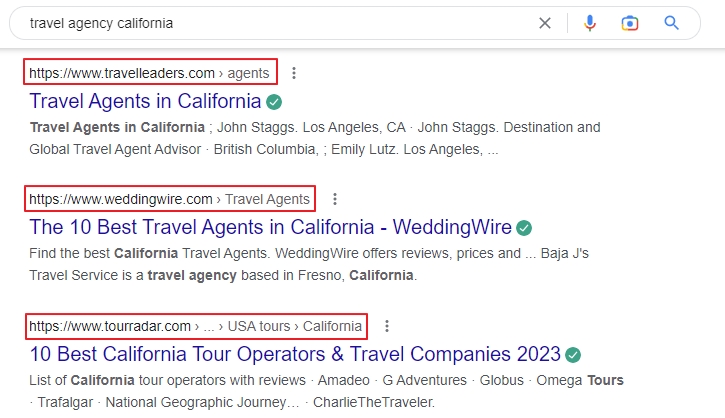
For a comprehensive list, I would recommend you look at different types of keywords and the SERP results for them.
If you are writing an educational blog and your main target keyword is “best California vacation spots,” you’ll also find popular and high DA websites like “travel.usnews.com.”

Keep in mind that it would be difficult to compete against big publications for the top spots on the first page of the SERPs.
This is especially true if you are only starting out a new blog that has low DA.
If your business works in multiple niches or you offer multiple services, you’ll need to check SEO competitors for each niche/service.
2. Use Specialized SEO Tools Like Semrush to Find Your Competitors
Another way to conduct a competitive analysis is to use keyword research tools like Semrush. It is one of the best SEO audit tools out there, and you can even use it for keyword research and competitor analysis.
You can use Semrush to find keywords that are relevant to your business, research the competition, and see how competitive those keywords are.
By understanding your competition, you can find keywords that are less competitive and easier to rank for.
How to use Semrush to find your SEO competitors while conducting SEO competitor analysis:
- Step 1: Log in to Semrush and go to “Domain Overview” in the Competitive Research section that you see on the left sidebar.
For this example, I want to check the main SEO competitors for the global shoe brand, “Skechers.” Even though it operates globally, I want to check the competitive landscape only in the USA.
- Step 2: Scroll down in the “Domain Overview” section to take a look at the top organic keywords and the top organic keywords by intent.
This can help you find more keywords to focus on and formulate a better SEO content strategy.
- Step 3: Scroll down to the “Main Organic Competitors” section and check the SEO competitors listed there.
Click on “View Details” for more in-depth information about your main SEO competitors.
- Step 4: In the “Competitive Positioning Map” section, you can check the overall visibility that an SEO competitor has in the SERPs. If the circle is larger on the map, that means the domain has more visibility.
If you look at the SEO competitors for Skechers, you can see that out of the five listed competitors, Shoe Carnival and Famous Footwear are close to the visibility that Skechers has.
I like how you can easily categorize your SEO competitors by taking a quick glance at this graph.
- Step 5: The “Organic Competitors” section has a list of the top domains along with the number of common keywords, SE keywords, traffic, costs, and paid keywords.
Exporting this list from Semrush will give you a list of your top organic SEO competitors.
- Step 6: If you want to dig deeper into any SEO competitor’s profile, you can click on their name from the list. This gives a complete overview of the “Organic Research” report on Semrush.
From their organic traffic to top organic keywords and organic position distribution, you can check it all here.
- Step 7: To get a comprehensive view of any SEO competitor’s profile, I like to check their Organic Research Semrush report as well.
You can do that by clicking on the “Organic Research” option on the left side of the SEO dashboard.
I like to check the “SERP Features” section to see if there are any special SERP results that are triggered based on the keywords that an analyzed domain is ranking for.
In this section, you can find if a domain has featured snippets, reviews, images, site links, and more links to it.
Using Semrush, you can gain a deeper understanding of who your SEO competitors are and what’s working for them. With these insights, you can even optimize your content strategy.
Before you get started with content creation, I would recommend you thoroughly check the SERP landscape of your niche/industry.
If your SEO competitors are ranking for your target keyword with a video, you should also think of creating a video to compete with them. To go the extra mile, you can create a full-length article and embed the video in it.
2. List Down Relevant Keywords You Want to Target
When it comes to SEO competitive analysis, not all keywords are weighted equal. During keyword research, you focus on finding keywords that have a high search volume and are relevant to your industry or business.
The easiest way to find relevant keywords is to check your SEO competitors’ keywords using a keyword research tool.
In Semrush’s Competitive Research report, you can check out the “Organic Research” section for any domain. You can pick a few SEO competitors and export their list to find keywords that might be relevant to you.
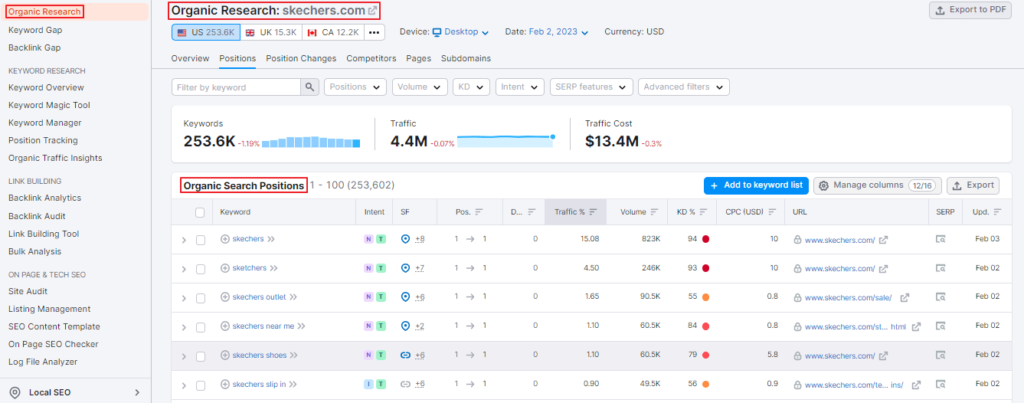
By using this data strategically, you can pick relevant keywords that have the potential to give you the highest ROI.
3. Look for Long-Tail Keyword Opportunities
If your site is small or not very well established, it can be intimidating to see mostly big publications making it to the top of the SERPs.
One way to bag the top spots in the SERPs is to focus on long-tail keywords instead of highly-competitive keywords.
For instance, here’s the keyword difficulty for the phrase, “shoes.”
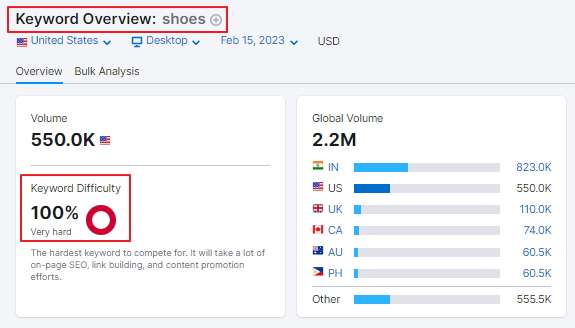
If you want to stand out from the crowd, you need to be more specific with the keyword you’re targeting. Think of terms like “canvas shoes for women.”
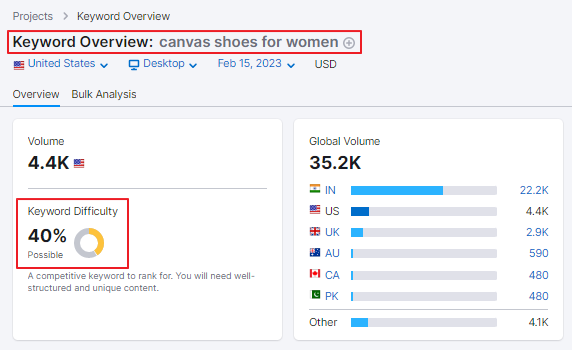
Those are examples of long-tail keywords. They have three or more words and are more descriptive than one-word keywords. These are also easier to rank for.
When you are conducting SEO competitive analysis, you should check for long-tail keywords and niche keywords. The search volume for such long-tail keywords may be low but they drive more relevant traffic. Plus, they will need less effort to outrank your SEO competitors.
4. Check Keyword Gaps
Ranking for a keyword from scratch may require a considerable amount of time. But that’s not the case with keywords that your site may already rank for.
Let’s say your site is listed at position six on the first page of Google while your main competitor is at position two. Getting ahead of them is going to require less effort than writing an SEO-optimized article and waiting for it to rank higher.
For the uninitiated, here’s what keyword gap analysis is all about:
Through keyword gap analysis, you can identify keywords that your SEO competitors are targeting successfully and the ones where you have a scope to outrank them.
This process helps you analyze all the keywords that are sending traffic to you and your competitors.
Keyword gap analysis can help you:
- Discover keyword opportunities to target.
- Uncover additional keywords to optimize your content.
- Find new content ideas.
- Get insights into your competitors’ strengths.
- Understand your audience’s intent and interests.
With competitor keyword gap analysis, your content and SEO team can get clarity on which keywords can generate maximum traffic. Based on that, you can create a priority list for keywords to target.
How to Check Keyword Gaps for Any Website
To check keywords that you and your competitors both rank for, you can use specialized tools for keyword gap analysis. Semrush, Similarweb, Link Assistant, and other similar tools provide the ability to check for keyword gaps.
Here is how you can use Similarweb to check for keyword gaps:
Step 1: Log in to your Similarweb account and select the “Acquisition Channels” option from the left side menu bar.
For this example, I have signed up for their free trial account.
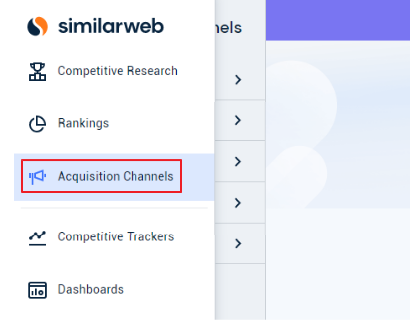
Step 2: From the given options, select “SEO” and “Keyword Gap.”
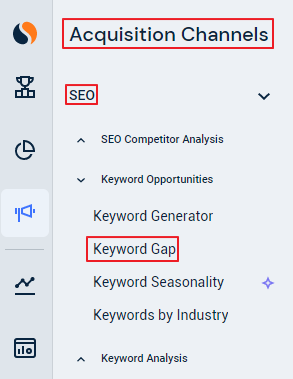
Step 3: Add two domain names in the niche that you’d like to compare and click on “See Keywords.”
For this example, I want to find keywords for “homedepot.com” based on the keywords of “walmart.com.”
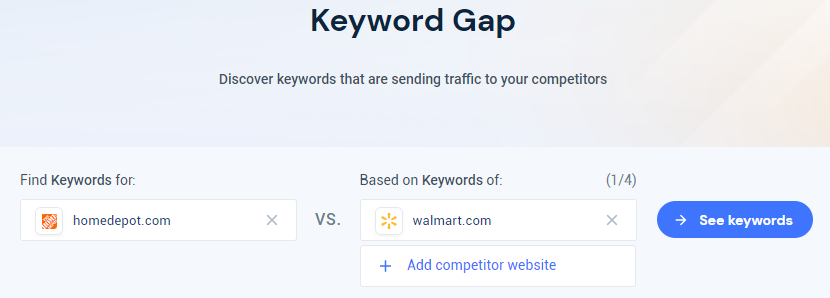
Step 4: The Venn Diagram shows the total number of keywords and search visits for both domain names. You can see the number of all shared keywords and search visits in the middle (overlapping) section.
Step 5: The default selected option is to view keyword gap for “All Traffic.” If you want to get results for organic and paid traffic separately, you can select “Organic” or “Paid” from the given options.
Step 6: Add keyword gap filter in the right section to find specific keywords shared by you and your SEO competitors. You can find the following options:
- Core Keywords: This option shows the keywords that you and your SEO competitors share.
- Wins: This option shows the keywords that you have a bigger share of traffic for.
- Opportunities: This option shows keywords your SEO competitors are getting traffic from, but your website isn’t.
- Losses: This option shows keywords that you are getting less traffic for than your SEO competitors.
For this example, I want to check organic keywords where Home Depot is getting less traffic than Walmart.
Once I set up the filters, I can see the keywords, “Black Friday Deals” and “Cyber Monday Deals,” are at the top of the keyword gap list.
If I were running the website for Home Depot, I would do some research to find answers to the following questions:
- Why is Walmart ranking for the given keywords?
- What kind of content does Walmart have for the given keywords?
- Does Walmart have an exceptionally high number of backlinks for related pages that is helping them rank higher?
- What should I do to target the listed keywords?
In my experience, answering these questions will help you find the most relevant keywords to target. You’ll also get a fair idea of how well of a chance you have of ranking for these keywords.
To get a more comprehensive view of the competitive SEO landscape, you can conduct keyword gap analysis for multiple SEO competitors at once.
5. Assess the Difficulty Level for Shortlisted Keywords
Let’s be honest – Theoretically, you can beat any of your SEO competitors in any industry or niche. But it’s not realistic.
You may not have the resources or the time to invest in getting ranked for your main keywords. Whatever the reason, targeting certain keywords may not be feasible for you.
That’s why you need to assess the overall difficulty level of your shortlisted keywords.
This requires a methodical approach and should involve a series of steps to ensure accuracy.
First, you should evaluate the search engine landscape to determine the type of search engine optimization (SEO) strategies your competitor uses.
This includes assessing multiple factors including:
- Domain age
- Domain Authority (DA)
- Domain country
- Traffic volume
- Backlink data
- Catalog listings
… and more!
Next, calculate the keyword difficulty scores of each of the shortlisted keywords. You can do this using a range of keyword difficulty analysis tools, such as Moz, Semrush, or Ahrefs.
Let’s say, my main target keyword is “walking shoes for women.”
For quick keyword difficulty assessment, I can enter this term in the search bar of Moz’s Keyword Explorer Tool.

When you click on “Analyze,” Moz gives you a quick difficulty score along with the monthly search volume, organic CTR, and priority of this keyword.
For the keyword I added, the difficulty score is 55 which is just slightly difficult. Moz gives this score based on the Domain Authority and the Page Authority for the listings on the first page of Google.

A difficulty score from 0 to 50 is considered relatively easy to outrank, while anything above 60 is difficult. For smaller websites, it is difficult to rank for keywords that have a difficulty score of 40 and above.
Keep in mind that it will require considerable time and investment to rank for keywords that have a high difficulty score.
6. Track Keyword Rankings Over Time
After assessing the difficulty level for shortlisted keywords for SEO competitive analysis, it is important to track how your keyword rankings change over time.
This can help you identify potential opportunities. You’ll learn where you stand in comparison to your competitors and what kind of content you need to publish.
You can track keyword rankings using rank tracking tools such as Sitechecker, Wincher, Serpstat, and others. These tools allow you to track keyword rankings over time and provide insights into the progress of the SEO campaign.
I am going to show you how to track keyword rankings over time using Sitechecker.
Step 1: Log in to Sitechecker’s Rank Tracker and configure the setting in Project Editing. Before you add keywords, you’ll need to add your search engine, city, language, device, and searcher domain.
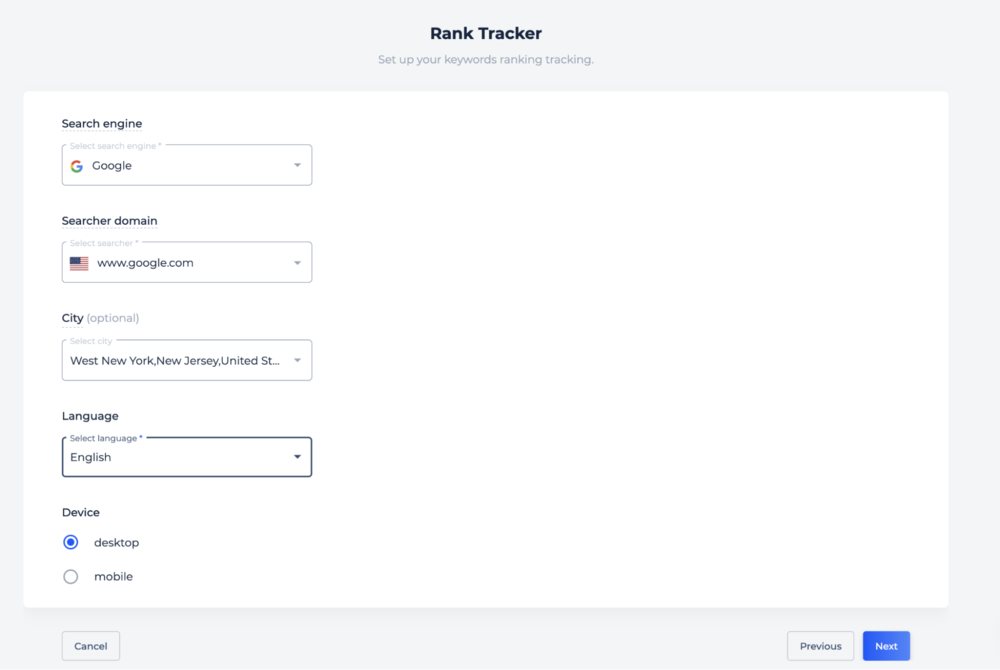
Step 2: Add the keywords that you want to track your rankings for. You can either type them or use the “Suggest Keywords” option [If you’ve connected your account to Google Search Console].
Alternatively, you can also import a file.
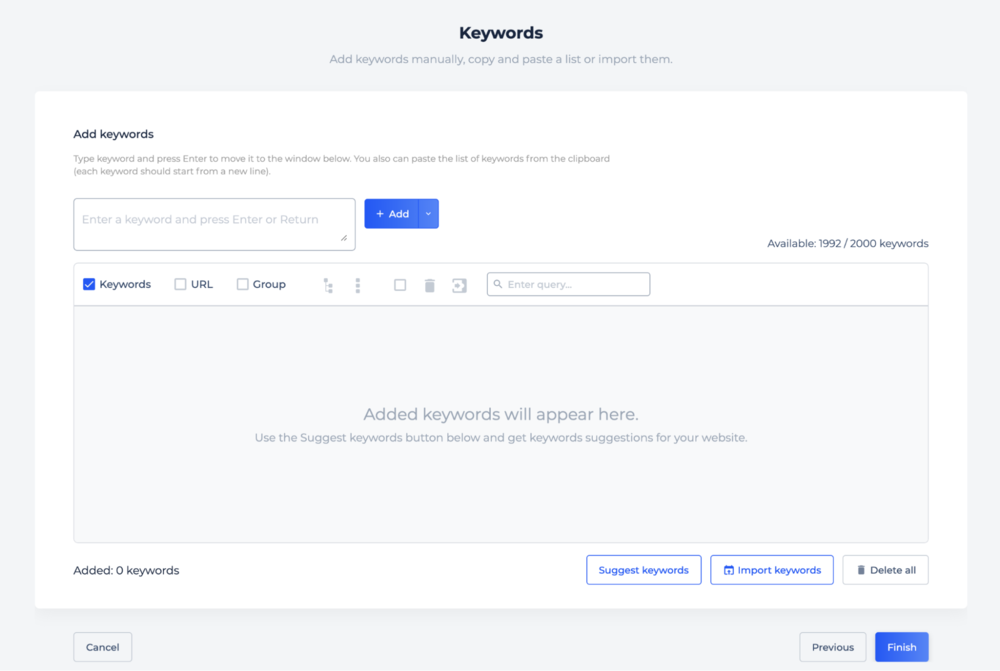
Step 3: Once you add the keywords, the tool will start to collect relevant data for your results. This process can take time. You should be able to see the first few results after a couple of hours.
After it’s set up once, your data is updated automatically once every day.
The first graph will show you the overall trend related to the keywords you’ve entered.

When you scroll down, you’ll also be able to see all the keywords and the changes in their positions every day.

Step 4: For a granular view of the keyword changes, toggle to the “Advanced” view from the top-right corner. You can also click on columns to select the metrics you’d like to add to your chart.
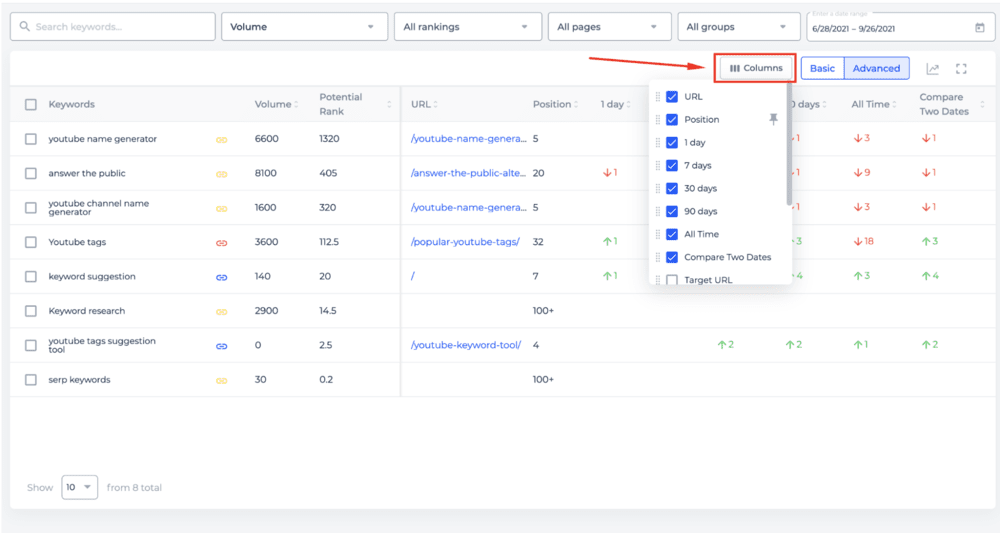
You can also export this data into .pdf or. CSV files so you can access it later as well.
7. Analyze SERP Results
Analyzing your competitor’s ranked content is a great way to understand your target audience and their search intent.
By looking at ranked keywords, you can gauge the needs of the readers and what kind of content would cater to them. For this, you need to first understand what search intent is and what are the different types of search intent.
Search intent refers to the main motive a user may have behind searching for a specific query on the internet.
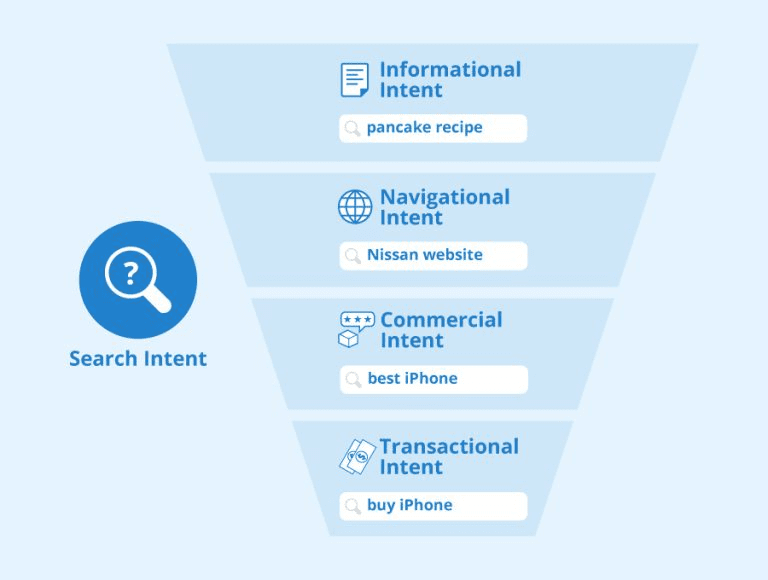
When it comes to SEO, search queries can be categorized into four main types of intent:
- Informational search intent
- Navigational search intent
- Commercial search intent
- Transactional search intent
Each search intent has a different user motivation. Let’s understand the needs of the user for each of these categories.
A. Informational Search Intent
When a user is looking for answers on a specific topic, their main motivation is to get as much relevant information as possible. They can be searching for the latest weather updates or may want to know how to fix their car.
Here is an example of informational search intent:
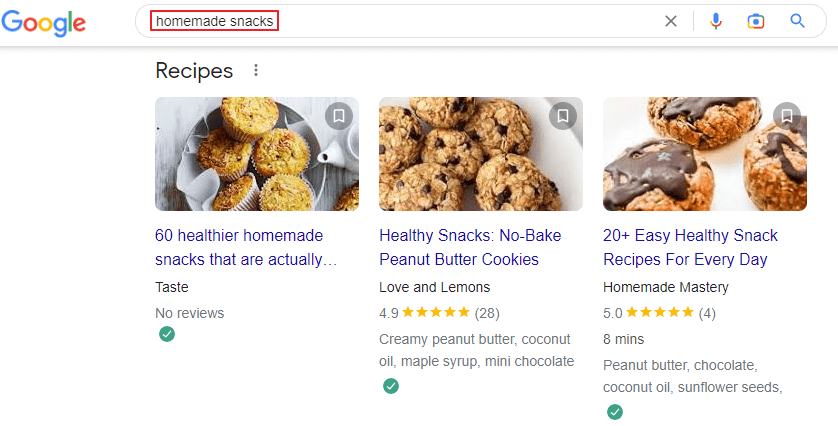
Image via Google
It is important to understand that Google’s understanding of the search intent goes deeper than looking at the search term.
In this case, Google understands that most users who search for “homemade snacks” are looking for recipes to make at home.
That’s why the SERP results have a featured snippet with posts catering to that search intent.
Type of Content That Caters to Informational Search Intent:
- Long-form blog posts
- Explainer videos
- Educational articles
- How-to posts
When you’re writing posts for this search intent, your focus should be on providing value through your content and explaining a concept/tool/feature.
You can add relevant product links in the post. But make sure it doesn’t come as pushy or unnatural in the context of the topic.
B. Navigational Search Intent
Users with this search intent usually want to navigate to a particular website or page. They may even search for a business name to find its website and other related information.
If a user searches for “Snapchat,” they are usually looking to visit the platform. That’s an example of navigational search intent.
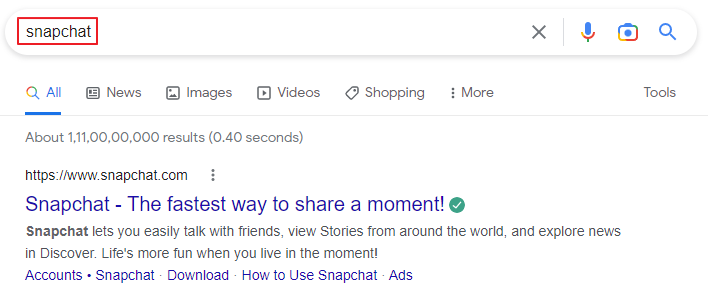
As you can see, Google understands the user search intent. That’s why the first result that of Snapchat’s homepage.
For this type of search intent, you should ensure that your business has good online visibility. When someone searches for your business on Google, they should be able to find the website and contact details easily.
However, keep in mind, that you’ll only get traffic for this search intent if users are actively searching for your business.
Type of Content That Caters to Navigational Search Intent:
- Homepage
- Landing pages
While creating content for this search intent, you should use the main keywords related to your niche, industry, and business.
Users who visit your website with navigational search intent may only have limited information about your business. To get ranked and get more traffic, you should write clear and concise copy that communicates what your business is all about.
C. Commercial Search Intent
Some users want to make a purchase but only after they do some research online. Such users have the willingness to spend money but they are exploring their options, investigating facts, and comparing prices.
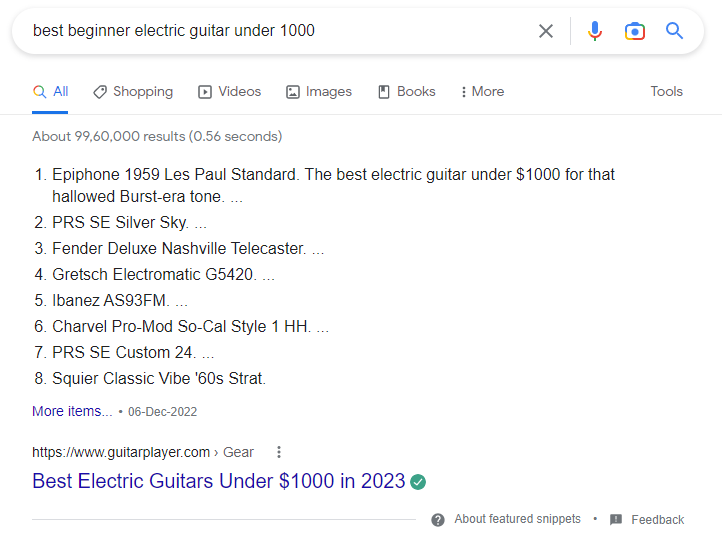
In the above example, the user is checking out options for electric guitars within a specific budget. In the featured snippet, you can see a list of the top 8 options so that the user gets the information they are looking for easily.
Phrases like “Under $1000” or “discount” show the purchase intent of the user. A listicle comparing different options satisfies the user intent here.
Type of Content That Caters to Commercial Search Intent:
- Listicles
- Reviews
When writing content for commercial search intent, ensure that you write about all the factors that are important to make a purchase decision. You can also include purchase links to convert some traffic into paying customers.
D. Transactional Search Intent
Users with transactional search intent are looking to make a purchase online. They already know what their requirements are and the options available.
After research, they’ve zeroed in on their preferred choice and want to make a purchase right away.

In the above SERP results, you can see that the pages ranking at the top all lead to the product page. For such search queries, Google might even share featured snippets as the first result.
Type of Content That Caters to Informational Search Intent:
- Product pages
- Reviews
As you can see from the examples listed above, all types of search intent require unique content to satisfy the needs of the reader.
A user who is searching for the best mobile phone won’t find a post on “the history of mobile phones” relevant. They want to know which mobile phones are available for them and where they can get the best deal.
By gauging the search intent of keywords and articles ranking in the SERPs, you can create more tailored content.
Check the search intent in your competitors’ posts closely. Based on that, you can improve your SEO content strategy.
8. Conduct a Technical SEO Audit
Conducting a technical SEO audit of your competitors' websites allows you to identify their technical strengths and weaknesses. This can help you develop a strategy to outperform them in search engine rankings.
While conducting a technical SEO audit of your SEO competitor websites, here are the things you should look at
- Site Speed: Analyze the loading speed of the website and identify the elements that are causing slow loading time.
- Mobile Responsiveness: Check whether the website is optimized for mobile devices or not.
- Crawlability: Verify if search engine bots can crawl and index all the pages on the website.
- Site Architecture: Analyze the site's structure and hierarchy, including the URL structure, internal linking, and sitemap.
- Technical Errors: Check for any technical errors, such as broken links, 404 pages, or server errors.
- Security: Verify if the website has an SSL certificate and is properly configured for secure browsing.
- On-page SEO elements: On-page optimization plays a critical role in how search engine bots crawl and understand the content on a website. On-page optimization includes elements such as:
- Meta description: Notice how your competitors are writing their meta description tags. Think of the meta description tag as a pitch that tells users what the page is about and why they should check it.
In the meta description on SERPs, look for the usage of keywords, CTA, and conciseness.
Google crawlers may not always use the description added in the meta description tag. However, they do use the tag to create featured snippets. - Titles: Check the title tag along with the title for the shortlisted web pages. Keep in mind that Google may rewrite title tags to include the site name or highlight a relevant keyword.
Sometimes you may find that exact match keywords aren’t in the title. That’s why take a look at both while checking your competitor’s web pages. - URL structure: A strong, hierarchical URL can help Google understand how your website is structured. While looking at the URL for competitor web pages, check the keywords added along with the categories mentioned.
If you are trying to outrank a competitor, you will need to look at the URL structure to understand the site hierarchy and categories. - <h> tags: Google pays attention to <h> tags as it helps them get context about the content on a web page. Plus, they improve the readability of the content. Here is an example of H2 and H3 from a blog post on my website:
Google crawlers may also use <h> tags to pick data for featured snippets. When analyzing competitor web pages, check how they are using <h> tags to organize their sub-sections in an article.
- Meta description: Notice how your competitors are writing their meta description tags. Think of the meta description tag as a pitch that tells users what the page is about and why they should check it.
If you want to learn how to use these SEO elements effectively on your website, please check out my post on on-page SEO.
9. Analyze Your Competitors’ Top Pages
After keyword research and analyzing SERP results, you need to gain a better understanding of your SEO competitors’ top-performing content. And by that, I mean you want to find your competitors’ content that earned them maximum links.
Getting quality backlinks is one of the most important ranking factors on Google. If you want to outdo your competitors, you need to find where they are getting the most links from.
While all major SEO tools offer an option for backlink analysis, I like using Moz for this, mainly because it is super convenient and free to use.
Here’s how to check pages with the most number of backlinks using the Link Explorer by Moz:
Step 1: Enter the domain name for which you’d like to check the top pages in the search box for Link Explorer.

Step 2: Check the section for “Top Pages on this Site.” The pages that have the highest Page authority are the top pages you need to focus on.
Step 3: For in-depth information, you can click on the section for a detailed overview. To sort the list according to Page Authority, you can change the status code to “200-OK.”
You can also export this data to a CSV file to check later.
Once you get the list, click on the URLs listed to check the content. Pay attention to the topic idea, and how the content is written.
Based on that, you can improve upon the existing content. Some tips to make your content better than your competitors:
- Break your content into multiple sub-topics.
- Add sub-topics in H2 and H3.
- Include bullet points to make your content more scannable.
- Add relevant images, videos, GIFs, and other multimedia content.
- Quote thought leaders.
- Include reliable statistics.
- Answer frequently asked questions related to the topic.
If you want more such tips, you can check out my post on, “How to Write Content that People Will Love to Read and Share.”
10. Conduct Competitor Link Analysis
Link gap analysis or competitor link analysis helps you identify sites and web pages that link to your competitors but not to your website. With this data, you can discover good links that may be easier to get.
These links are easier to obtain because:
- They have already demonstrated an interest in your industry or niche.
- They have published content related to the keywords you are targeting.
To get links from these sources, you can reach out to them and show them that you can provide them with better content than your competitors.
In my experience, this strategy gives you a better-than-average chance of earning a link.
How to Check Backlink Gap Using Semrush
Before you go for link gap analysis, it’s a good idea to conduct a backlink audit for your website. That way, you’ll be able to understand what your backlink portfolio looks like.
After that, the next step is to find relevant pages that link to your competitors but not to your site. Here is how to conduct a link gap analysis using Semrush:
Step 1: Go to the “Backlink Gap” tool on Semrush and enter all the domain names that you’d like to compare. For this example, I am comparing two skincare brands: Glossier and Fenty Beauty.

Step 2: Take a look at the table and the graphs to get a quick comparison of the competitors’ backlink profiles. With the trend graph, you’ll be able to figure out which competitor has more backlinks.
For our comparison, Glossier clearly has the bigger backlink portfolio among the two brands.

Step 3: Scroll down to check the referring domains that send backlinks to the domain names you’ve entered. By default, the tool is programmed with a “You-Domain” setting. That means you’ll see link opportunities that you can reach out to.
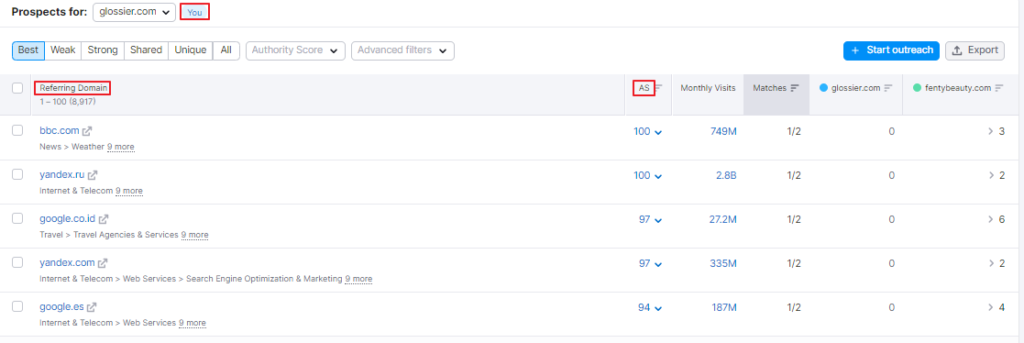
You can target these websites to gain the backlinks your competitors have. In Semrush, you can also filter the domain results in five different ways: Best, Weak, Strong, Shared, and Unique.
Here is what these filters mean:
- Best: This is a list of domains that link to all your competitors but not to you.
- Weak: This is a list of domains that link back to you less often than your SEO competitors.
- Strong: This is a list of domains that point to your website but not to your SEO competitors.
- Shared: This is a list of domains that point to you as well as your SEO competitors.
- Unique: This is a list of domains that point to only one specific domain.
Currently, Semrush can only show a trend graph between different domains. But if you want to compare different sub-domains from the same domain name, Semrush won’t be able to provide you with the backlink trends. If you want to compare the backlink profiles of multiple domains at once, you can use also use Semrush’s Bulk Backlink Analysis tool. Using it, you can compare up to 200 URLs simultaneously.
6 Mistakes You Should Avoid While Conducting SEO Competitive Analysis
After having conducted SEO competitive analysis multiple times, I’ve understood it can be an overwhelming process for beginners. After all, it involves much more than looking at your competitors’ website metrics. It also requires an understanding of their content and overall digital marketing strategy.
To ensure that your SEO competitive analysis is as effective as possible, avoid these common mistakes:
1. Not Defining Your Goals Clearly
The first mistake to avoid when conducting SEO competitive analysis is failing to set clear goals. Without clear goals, it will be impossible to determine the success of your analysis.
Is your focus on boosting traffic, increasing conversions, or reducing the bounce rate?
Before you start SEO competitive analysis, set clear goals about what you want to achieve. Include what you want to achieve along with a defined time frame and how you will measure your progress.
Additionally, it is important to clearly define the scope of the analysis. Determine which competitors you will include and the metrics you’ll track.
2. Solely Relying on Metrics
Do not rely solely on metrics to determine the success of a competitor’s strategy. It is important to understand their content strategy, including:
- Topics covered
- Type and quality of content published
- Frequency of their posts
Additionally, research their link-building strategy, including the types of links they acquire and the sources they use. This can help you create an informed content strategy and ensure that you are producing content of a higher quality than your competitors.
3. Focusing Only on Organic Search
When conducting an SEO competitive analysis, it is a mistake to focus exclusively on organic search. Your competitors may be using paid search, social media marketing, and email marketing, which you also take into account.
Analyze the channels they are using and the strategies they are employing to determine which tactics are working best. It will also help you identify opportunities for your own website.
4. Focusing on the Number of Keywords
Another mistake to avoid while conducting SEO competitive analysis is focusing too much on the number of keywords that a website is targeting.
While this is important to look at, it is also important to look at the type of keywords they are targeting.
Are they ranking for high-traffic keywords with low competition or low-traffic keywords with high competition?
Understanding the level of keyword difficulty will help you gauge how well the website is ranking for those keywords.
5. Not Checking Your Own Progress
Don’t lose sight of your own progress while keeping an eye on your competitors. Track how you are doing with respect to your goals and how much progress you are making.
Check if your SEO efforts are paying off and if you’re able to move up in the rankings.
SEO competitor analysis is only effective if you clearly know where you stand in relation to your competitors.
6. Not Conducting Mobile-Specific Competitor Analysis
Over 60% of the internet population use mobile phones to go online. Because of the increasing number of mobile phone users, Google even rolled out mobile-first indexing.
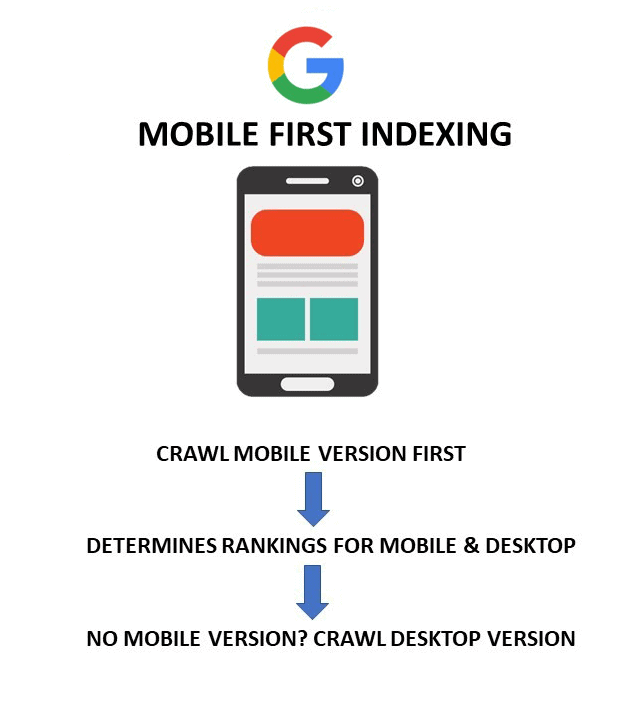
With the introduction of this system, Google crawls the mobile version of a website first. If it is not available, only then Google crawls the desktop version.
It’s evident that the mobile site is the driving factor for ranking and indexing. That’s why it’s important to conduct a mobile-specific competitor analysis.
While checking your competitors’ websites for mobile optimization, here is what you should look for:
- Responsive design
- Mobile page loading speed
- Mobile content quality
- Placement of ads
Ideally, a website should provide a smooth user experience on desktop as well as mobile devices. If you see errors or temporary image loss, the site might not be properly optimized for mobile devices.
To get a mobile-specific analysis of any website, you can take Google’s Mobile-Friendly test. Let’s say, I want to check if the homepage of Lonely Planet is mobile-friendly. For that, I just need to enter the URL and click on “Test URL.”
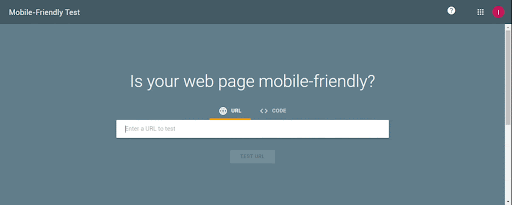
After analyzing the page for a minute or two, Google shows that their page is mobile friendly. This is a good starting point to check any website’s mobile-friendliness.
Additionally, you can also check the page loading speed of any page using Google’s PageSpeed Insights tool.
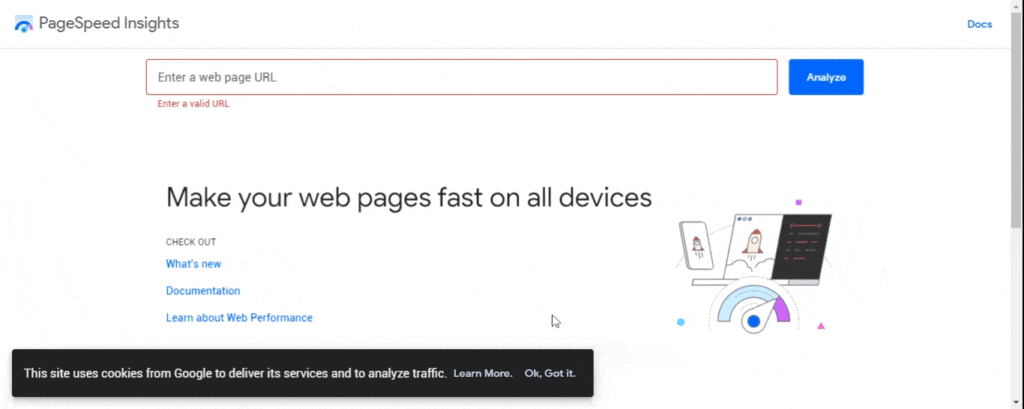
Google evaluates any web page’s performance based on how quickly the browser can render the first bit of content and the loading time of the largest visual. It is based on six main metrics and is calculated on a scale of 0-100.
For Lonely Planet, Google shows that the overall performance is “25.” While that is low, the site scores really well in terms of SEO, accessibility, and best practices.
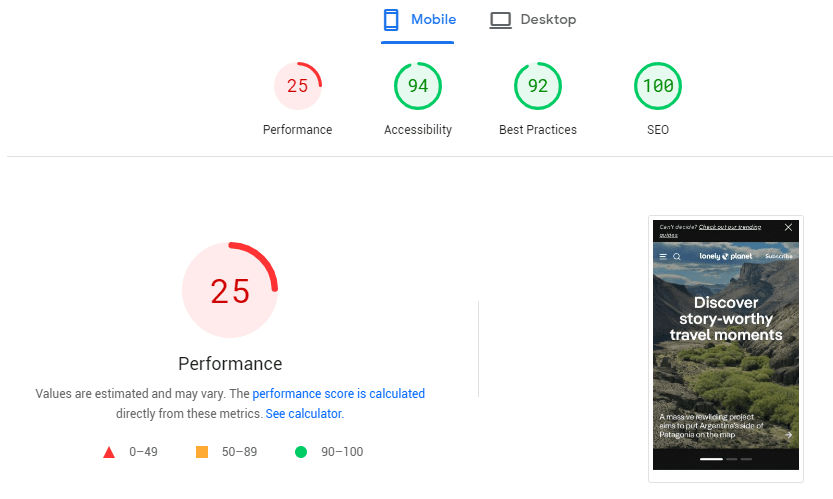
Ready to Conduct SEO Competitor Analysis?
SEO competitive analysis is necessary to gain insight into the current state of your market and to ensure that your website is well-positioned for success.
By studying the search engine optimization tactics of your competitors, you can identify opportunities for improvement and develop a strategic plan to outrank them.
Additionally, it is important to measure the success of your own SEO efforts by tracking your rankings and the overall performance of your website.
With regular analysis, you can stay ahead of the competition and drive more traffic to your site.
Do you have any questions related to SEO competitor analysis? Please feel free to mention them in the comments section. I will be happy to answer your questions.


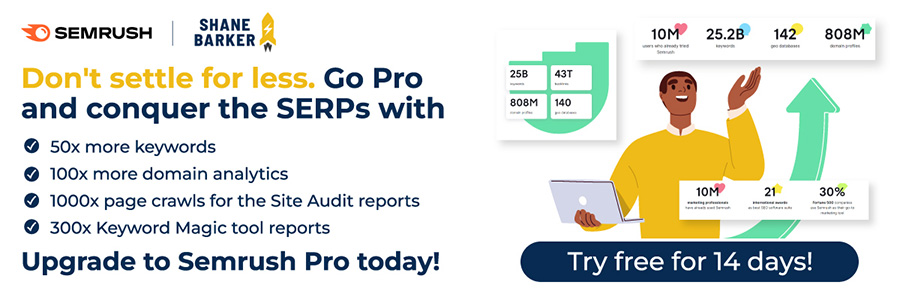


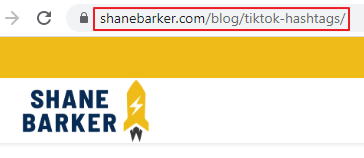
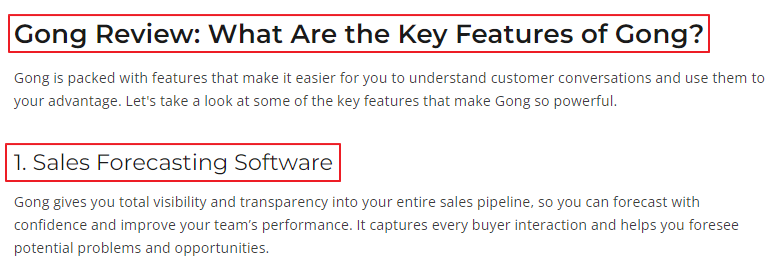

Related Articles
15 Best SEO Tools For All Marketers (Free + Paid Platforms)
Learn How to Do an In-Depth Technical SEO Audit in 9 Steps
20 Best SEO Chrome Extensions That You Need to Know in 2024
8 SEO On-Page Factors That Can Affect Your Search Results Rankings
15 Best SEO Audit Tools
20 Best SEO Plugins for WordPress You Need To Know Right Now